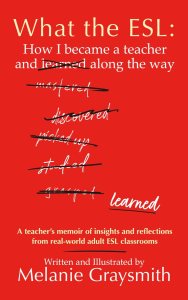Synopsis:
This one-of-a-kind memoir shares the author’s memories of teaching experiences and interactions over a span of time. More than a teacher’s story, What the ESL amplifies the voices of learners’ real-life stories from adult ESL classrooms. As a hybrid memoir, woven into the learner stories is a benefit for readers to come away with. No matter what level of familiarity readers may have with foreign language study, there is always something relatable in the effort to succeed. With warmth, insight, and humor, the author offers a moving portrait of language learning through a teacher’s eyes and the myriad paths learners take striving to master English while managing complex lives.
Whether you’re an educator, language student, or simply fascinated by conversation, this book helps you rethink your assumptions about ESL learners and the teaching journey.
Discover the varied motivations and goals of adult ESL learners
Step into the classroom through the teacher’s eyes
Understand how empathy, humor, and cultural intelligence shape language teaching
Gain a deeper appreciation for the persistence of adult learners
Favorite Lines:
“Creativity has always defined my strengths and led me forward or sheltered me in times of need.”
“It’s crucial for teachers to adapt and embrace new technology and teaching methods to remain up to date.”
“Fortunately, my creativity always saved my spirits; it was my lifeline, my comfort.”
My Opinion:
I received a copy of this book from the author in exchange for my honest opinion.
There’s something comforting about reading a memoir that feels like sitting in the back of a classroom — not as a student, but as someone who’s quietly observing the rhythm of learning. In What the ESL, Melanie Graysmith opens that classroom door and invites us in, one story at a time.
What starts as a modest recollection of her first day teaching quickly turns into a lifetime’s worth of insight about language, culture, and the strange beauty of human connection. You don’t have to be a teacher to relate — you just have to have ever tried to make yourself understood in a world that doesn’t always speak your language.
Graysmith’s voice is warm and witty, often self-deprecating but never cynical. She writes with the humor of someone who has learned to find joy in chaos — a classroom without a plan, a lesson that veers off course, a student’s heartbreaking confession that becomes a turning point. Through each chapter, she balances teaching anecdotes with cultural snapshots — Saudi students navigating independence, a French man misinterpreting “pull over,” a Venezuelan sharing his love for arepas.
The memoir’s greatest strength lies in its empathy. Every story — even the small, funny ones — reminds you that language is never just grammar and pronunciation. It’s identity. It’s power. It’s the bridge between who we are and who we hope to become.
This book reads like a letter to anyone who’s ever stumbled through a new beginning: teachers, travelers, lifelong learners. It’s about resilience, but also about grace — the quiet kind that grows from listening more than speaking.
Summary:
Overall, What the ESL is a celebration of connection — between teacher and student, between languages and cultures, and between mistakes and growth. It’s a memoir that doubles as a love letter to the messy, beautiful process of learning.
Graysmith’s stories span decades and continents, yet the heart of the book stays the same: curiosity, compassion, and the humility to keep learning alongside the people you teach.
Readers who love memoirs of teaching, cross-cultural stories, or human-centered nonfiction will find something special here. It’s especially for those who believe language is more than words — it’s understanding. Happy reading!
